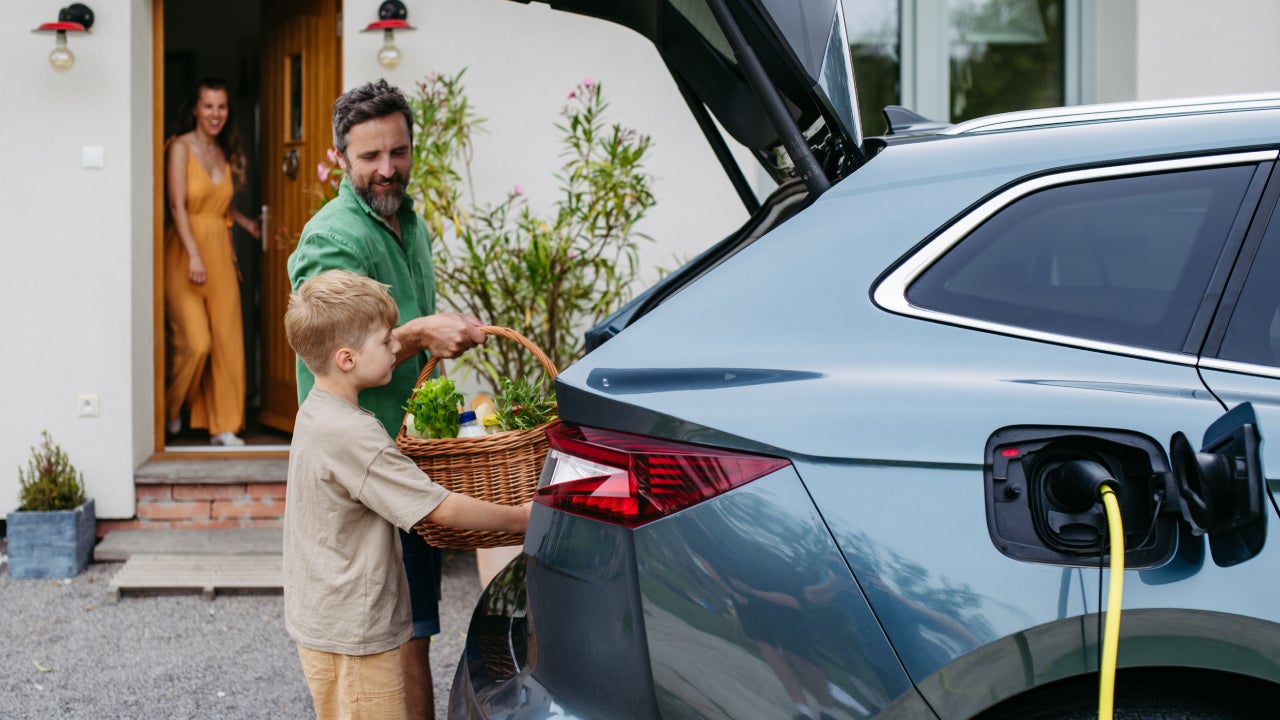Electric vehicles, also commonly referred to as EVs, have come a long way in the last decade. Once expensive and niche, EVs are now more affordable, have a greater driving range and come in various styles. With federal and state incentives available to support electric vehicle purchases and a wide range of models to choose from, EVs are becoming popular for drivers interested in alternative fuel options and fun tech features.
Electric cars in 2025
EV facts and stats
- Electric cars’ share of the car market has increased from 4 percent in 2020 to 18 percent in 2023. (IEA)
- There are more than 192,000 public EV charging stations across the country. (U.S. Department of Transportation)
- In March 2023, San Francisco became the first-ever major metropolitan city where half of all new vehicle registrations were electric vehicles. (S&P Global Mobility)
- There are 40 million EVs on the road globally. (IEA)
- The number of available electric car models could reach 1,000 by 2028. (IEA)
- By 2035, IEA projects there will be 78.5 million EVs on the road in the U.S. (IEA)
- Potential rollbacks to the $7,500 consumer tax credit for electric vehicle purchases may increase the cost of EVs in 2025. (Reuters)
In the early 2000s, the Toyota Prius was synonymous with electric cars. With countless A-list celebrities switching to this compact hybrid, electric vehicles found a foothold in pop culture. Fast-forward 25 years, and electric cars account for almost one-fifth of new vehicle purchases worldwide, according to the International Energy Agency (IEA).
As more electric cars are produced, the cost of producing batteries has dropped, making EVs more affordable. Innovation and increased competition among EV manufacturers have resulted in stylish and tech-forward vehicles that appeal to mainstream drivers, not just environmentalists or gearheads. In fact, the lack of gears, or really, the lack of typical gas-powered vehicle components like a combustion engine and transmission, is a major draw for many consumers. At least it was for Kyle Getson:
I am a tech guy, not a car guy. I’ve always hated car dealers, repair shops, etc., because I’m not knowledgeable, and it was always hard to know what I really needed to have done. Electric cars don’t have timing belts, alternators or lots of other things combustion engine cars have. And I prefer having fewer parts, less maintenance and a screen to describe any problems that may come up.
— Kyle Getson, Senior vice president of engineering, Bankrate
Another reason EVs are gaining popularity is the growing number of charging stations popping up all over the country. Thanks to President Biden’s Investing in America agenda, there are 192,000 public charging ports, with about 1,000 new ports added each week. This helps alleviate the “range anxiety” of many potential EV owners — the fear of running out of battery power and not having a way to charge their car.
The electric vehicle market today
Electric vehicles are not a passing trend. A recent survey by Consumer Reports found that more than one-third of Americans would “definitely” or “seriously consider” buying an electric vehicle if they were to purchase a new car today. Other interesting electric car facts include:
EV market growth facts
- The first electric vehicle was created in 1832. (Energy.gov)
- By comparing the national average cost per kilowatt-hour of $0.176 to the average cost of a gallon of gas at $3.06, an EV driver could save around $513 a year on energy costs. (U.S. Bureau of Labor Statistics, AAA and Chargevc)
- A Tesla Roadster is faster than most sports cars, with an acceleration speed of 0 to 60 in 1.9 seconds. To compare, a Ferrari or Lamborghini accelerates from 0 to 62 in 2.8 to 2.9 seconds. (Tesla and Auto Express)
- The majority of EV car sales are in three markets: China, Europe and the United States. China leads the way with 60 percent of EV car sales globally. (IEA)
- EV car usage is on target to avoid the use of 5 million barrels of oil per day by 2030 (IEA)
- 77 percent of people who want to purchase an electric vehicle cite saving money on gas as the primary reason. (AAA)
- 50 percent of adults in the U.S. say they are not too or not at all likely to consider purchasing an EV. (Pew Research Center)
- 60 percent of consumers avoid EVs because they worry there are not enough places to charge. (AAA)
- Many new EVs can take up to 12 hours to charge if using a Level 2 outlet. (Kelley Blue Book)
- Tesla’s Model Y was the best-selling car of 2023 for both EVs and internal combustion engine vehicles. (Kelly Blue Book)
What is an electric car?
An electric car is one that is either powered by an electric motor that solely draws energy from a rechargeable battery or powered by both an electric motor and an internal combustion engine (a hybrid EV). An EV’s battery is charged using an external power source at home or an EV charging station.
Most popular EVs
Five manufacturers make up more than 50 percent of non-hybrid battery-operated electric vehicle sales worldwide. According to CleanTechnica, the most popular EV brands in the U.S as of Q3 2024 are:
- Tesla
- Ford
- Chevy
- Rivian
- Hyundai
When looking at individual vehicle sales, Tesla is a clear favorite among drivers. Below are the top 10 EVs sold in the third quarter of 2024:
| EVs | Amount sold in Q3 2024 |
|---|---|
| Tesla Model Y | 86,801 |
| Tesla Model 3 | 58,423 |
| Tesla Cybertruck | 16,692 |
| Ford Mustang Mach E | 13,392 |
| Honda Prologue | 12,644 |
| Hyundai Ioniq 5 | 11,590 |
| Chevy Equinox EV | 9,772 |
| Chevy Blazer EV | 7,998 |
| Rivian R1S | 7,245 |
| Cadillac LYRIQ | 7,224 |
Types of electric cars
Electric cars come in three main types:
- Hybrid electric vehicles (HEVs): HEVs combine a gas-powered engine with one (or more) electric motors. An HEV does not plug in; it collects energy through regenerative braking. The Toyota Prius may be one of the best-known HEVs.
- Plug-in hybrid electric vehicles (PHEVs): Similar to an HEV, the main difference is that a PHEV is able to plug in to charge. The Prius also comes as a plug-in version.
- Battery electric vehicles (BEVs): Also known as an all-electric car, BEVs need to be plugged in to recharge. Teslas are BEVs.
BEVs and HEVs are becoming the more popular option for drivers over PHEV’s.
How do electric cars work?
An electric vehicle works similarly to internal combustion engine (ICE) vehicles. However, EV drivers may spot some differences from ICEs, such as:
- Quiet operation: Many passersby often get startled and say they did not hear an EV approaching, and first-time owners say they are sometimes unsure if their car is on.
- Sluggish acceleration: Some hybrid EVs are designed to accelerate slowly and coast, which takes some getting used to. However, electric plug-ins, such as Teslas or Porsche EVs, are very fast.
- Marked deceleration: EVs typically take advantage of regenerative braking to recharge the battery. Letting off the accelerator could cause the car to noticeably slow down more than a regular vehicle.
- Extra trunk or “frunk” space: Pure EVs don’t have a combustion engine. Therefore, the front hood is empty and, in many models, used as a front trunk.
Pros and cons of electric cars
Electric vehicles have come a long way in the last few years, especially in terms of tech and gadgets. For Getson, tech features like security cameras and Tesla’s mobile app are some of the best parts of owning an EV. “Over-the-air updates happen every month or two,” says Getson. “My car has gotten more efficient and faster since I bought it just from software updates. I feel like everyone else has a flip phone, and I’m driving around in my iPhone.”
But not everything is perfect and EVs still fall short for many drivers. In addition to the electric car facts already covered, consider the following benefits and drawbacks.
Pros
- Energy-efficient: EVs directly convert more than 85 percent of electrical energy into motion, compared to internal combustion engines, which convert less than 40 percent.
- Lower maintenance costs: EVs do not have an engine that needs maintenance or oil replacement. And in the case of pure-electric vehicles, brake use is minimal due to the regenerative braking that automatically slows the car down when you let your foot off the accelerator.
- Smaller environmental impact: EVs do not emit pollutants from tailpipes and do not require as much (or sometimes any) gasoline.
Cons
- Cost: While electric cars have become much cheaper, they are still more expensive than ICEs. At the end of 2024, the average new car cost $48,724, while an average EV was $55,105, according to Kelley Blue Book.
- Range: According to the U.S. Department of Energy, electric vehicles can only travel 260 to 400 miles on one charge, depending on the model.
- Charging: Charging an EV takes much longer than filling up a car with fuel. Charging a new electric vehicle can take up to 12 hours using a Level 2 charger, although Tesla Superchargers can charge Teslas in as little as 15 minutes.
How much do electric cars cost?
Many factors affect the cost of owning and driving an electric vehicle, and the first consideration for most drivers is the difference in purchase price between ICEs and EVs:
Another recurring cost drivers should keep in mind is insurance. Although the gap is narrowing, it still generally costs more to insure an electric vehicle than a comparable ICE model.
The cost of electric car insurance varies greatly depending on the make and model of the vehicle and additional factors like driving record and coverage type. Getting quotes from your insurance agent for several types of EVs can help you find an electric vehicle within your insurance budget. Some insurance companies even offer an EV discount. The average cost of car insurance for an ICE is $2,638 per year for full coverage. The table below shows how average costs compare for some popular EV models:
| Electric vehicle | Avg. full coverage premium |
|---|---|
| BMW i4 | $3,757 |
| Ford F-150 Lightning | $2,895 |
| Ford Mustang Mach-E | $3,314 |
| Hyundai Ioniq 5 | $2,905 |
| Kia EV6 | $2,843 |
| Rivian R1S | $4,193 |
| Tesla Model 3 | $3,394 |
| Tesla Model X | $5,142 |
| Tesla Model Y | $3,679 |
Bottom line
Technology and infrastructure advancements are making EVs a competitive alternative to gas-powered cars, especially if you’re already in the market for a new ride. You could stop worrying about gas prices and become part of the sustainable movement without compromising performance or fun. However, the cost of purchasing an EV is still considerably higher than an ICE, and depending on where you live, charging your vehicle could still be a challenge and an added cost. With depreciation taken into account, going electric might not save as much money as you anticipated, so it’s generally a good idea to do a personalized assessment of how the cost of ownership would stack up for an EV compared to a gas-powered vehicle.
Methodology
Bankrate utilizes Quadrant Information Services to analyze January 2025 rates for all ZIP codes and carriers in all 50 states and Washington, D.C. Rates are weighted based on the population density in each geographic region. Quoted rates are based on a single, 40-year-old male and female driver with a clean driving record, good credit and the following full coverage limits:
- $100,000 bodily injury liability per person
- $300,000 bodily injury liability per accident
- $50,000 property damage liability per accident
- $100,000 uninsured motorist bodily injury per person
- $300,000 uninsured motorist bodily injury per accident
- $500 collision deductible
- $500 comprehensive deductible
To determine minimum coverage limits, Bankrate used minimum coverage that meets each state’s requirements. Our base profile drivers own a 2023 Toyota Camry, commute five days a week and drive 12,000 miles annually.
These are sample rates and should only be used for comparative purposes.
Model: To determine cost by vehicle type, we evaluated our base profile with the following vehicles applied: BMW i4, Ford F-150 Lightning, Ford Mustang Mach-E, Hyundai Ioniq 5, Kia EV6, Rivian R1S, Tesla Model 3, Tesla Model X, Tesla Model Y and Toyota Camry (base).
Read the full article here
















